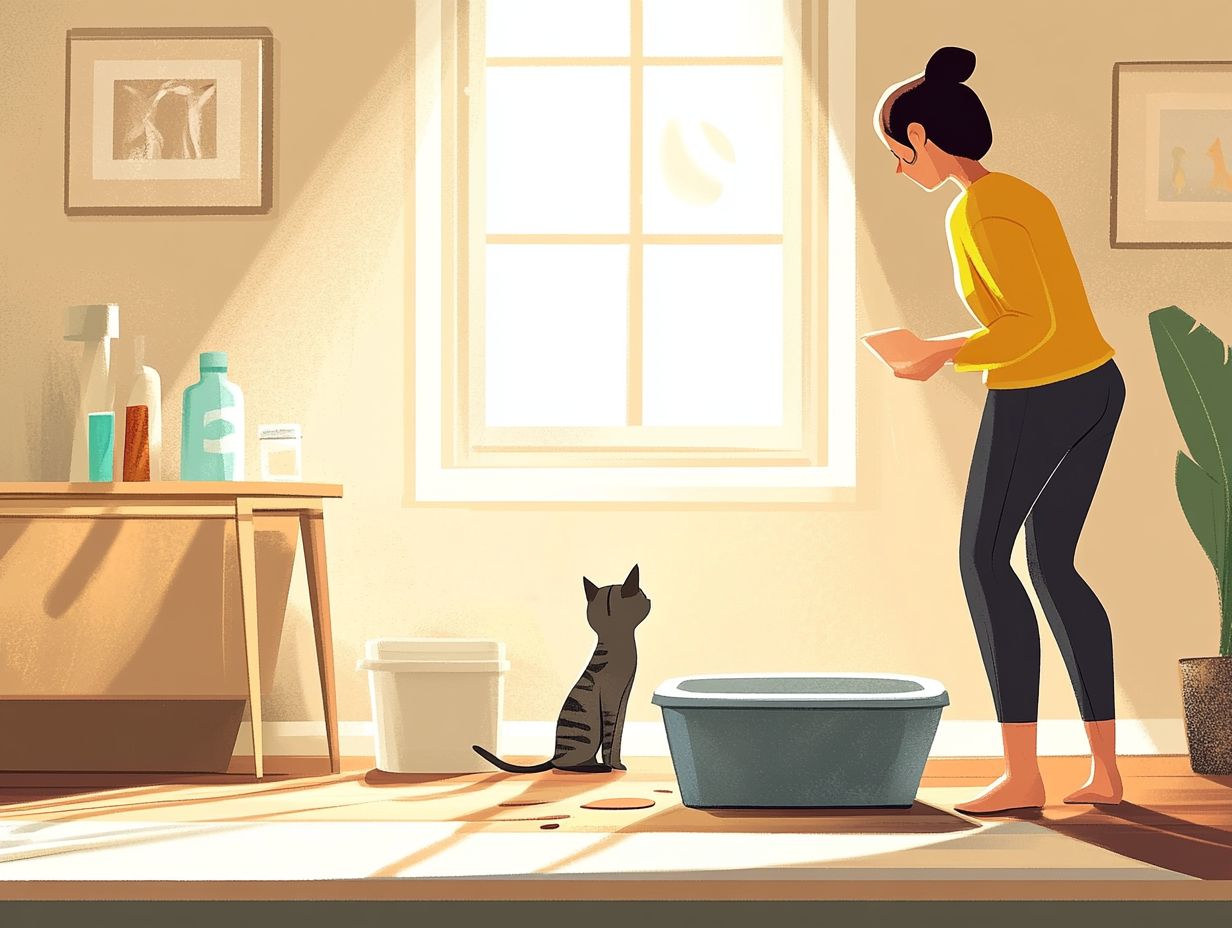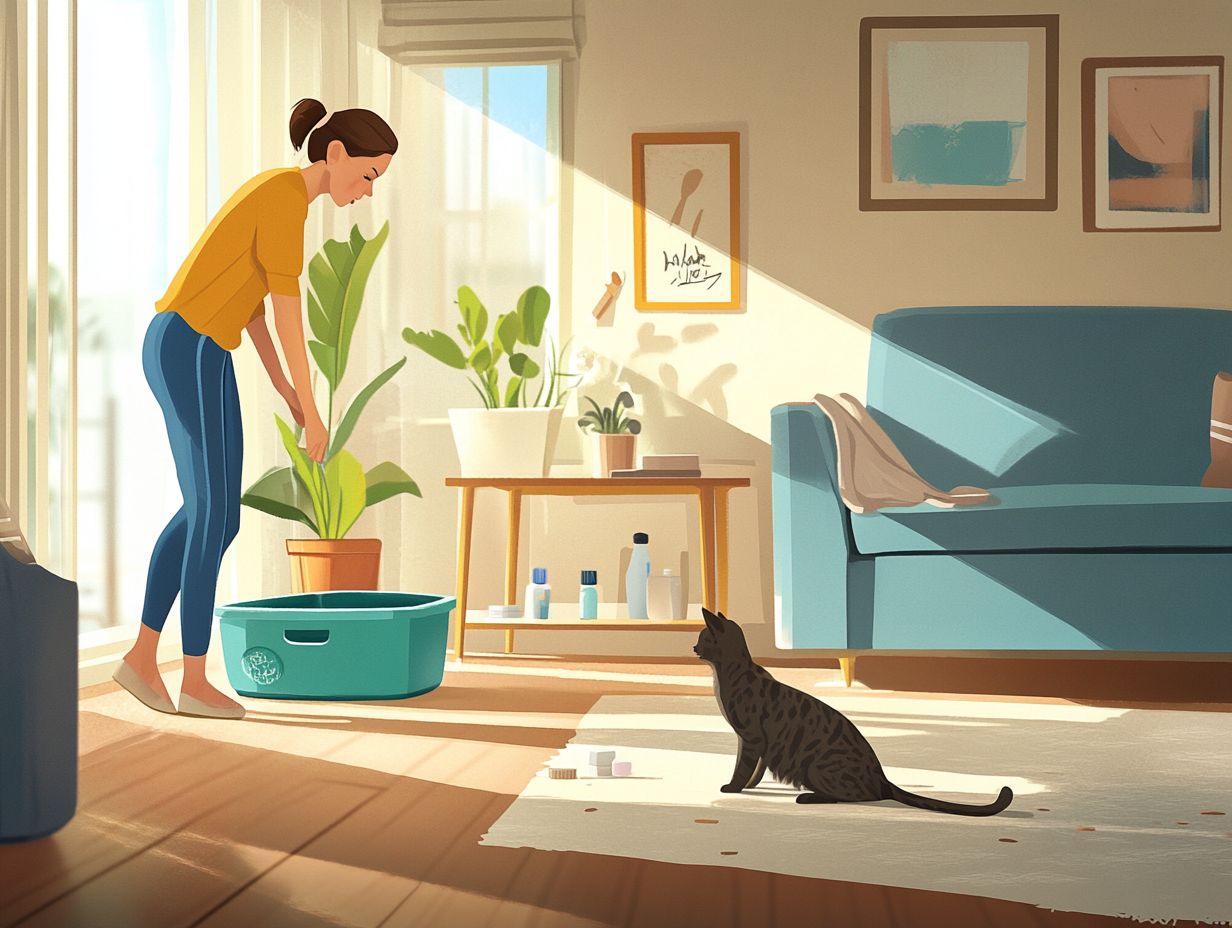If you’ve ever found your cat urinating outside the litter box, you know how frustrating and concerning it can be, potentially leading to behavioral disorders if not addressed.
Understanding why this happens is important for both your cat’s well-being and your peace of mind, as behavioral problems can arise from unresolved issues.
This article explores the common causes of inappropriate urination, from medical issues such as urinary tract infections and feline idiopathic cystitis (a painful bladder condition in cats) to behavioral problems and environmental stressors like new pet introductions and cleaning products.
It also provides practical solutions and preventive measures, including aversion therapy and litter box maintenance, to help ensure your feline friend uses the litter box consistently.
Read on to discover insights into cat behavior that can help you and your feline companion find a harmonious solution.
Key Takeaways:

- Inappropriate urination in cats can be caused by medical issues, behavioral problems, litter box issues, and environmental stress, necessitating owner dedication to resolve.
- To determine the cause of your cat’s inappropriate urination, consult with a veterinarian, observe their behavior, check the litter box setup, and assess any environmental changes, such as new pet introductions or cleaning products.
- Solutions for inappropriate urination in cats include addressing medical issues, utilizing behavioral therapy, improving litter box conditions—ensure your cat has one litter box per cat, plus one extra—and reducing environmental stress through techniques like calming pheromones and urine neutralizing cleaning techniques.
Why Do Cats Pee Outside the Litter Box?
Understanding why cats urinate outside the litter box is essential for helping owners tackle the frequent and distressing problem of inappropriate urination in felines. This common behavioral issue often indicates an underlying problem, which may be either behavioral or medical.
Factors contributing to inappropriate urination include stress management, litter box cleanliness, litter preferences, and the overall comfort of the cat’s environment—all crucial aspects of feline welfare and cat health. By addressing these issues, owners can create a more comfortable atmosphere for their pets, potentially preventing further behavioral deterioration and supporting overall cat welfare.
What Are the Common Causes of Inappropriate Urination in Cats?
1. Medical Issues
Medical issues are a primary cause of inappropriate urination in cats and can lead to serious complications if not addressed promptly. Common conditions, such as urinary tract infections and feline idiopathic cystitis, can manifest through this behavior, causing discomfort and distress for the affected cat.
It is crucial for cat owners to consult a veterinarian to rule out these medical issues, as prompt veterinary care is essential for maintaining your cat’s health. Other potential underlying conditions may include bladder stones, diabetes, and kidney disease, each presenting unique symptoms such as frequent trips to the litter box, blood in the urine, or other medical conditions.
Diagnosing these issues typically involves thorough examinations, including urinalysis and imaging studies, conducted by veterinary professionals, ensuring comprehensive cat health care. Treatment options can vary, ranging from antibiotics for infections, dietary changes for stone management, holistic therapies, to more extensive care for chronic diseases. For more insights, check out Why is My Cat Peeing Outside the Litter Box? Causes and Solutions.
Regular wellness check-ups and attentiveness to behavioral changes can help catch problems early, ultimately leading to better outcomes and a happier life for the cat.
2. Behavioral Problems
Behavioral problems are a significant cause of cat peeing outside the litter box, often stemming from stress and anxiety due to changes in their environment or household. Cats can develop different behavioral issues that result in urinating outside the litter box.
Common stressors include the introduction of new pets, alterations in household routines, loud noises, or conflicts with other animals. These factors can lead to emotional distress and may trigger an instinctual response to mark territory or exhibit other behavioral issues. Identifying these triggers is essential for effective intervention.
Techniques for behavioral modification, such as positive reinforcement—rewarding your cat immediately after it uses the litter box—can be employed. Additionally, stress management strategies—such as creating a safe space, implementing anxiety medication, or utilizing calming pheromones—can help restore your cat’s appropriate behavior and encourage proper litter box use.
3. Litter Box Issues
Litter box issues are among the most common reasons for inappropriate urination in cats, and they can stem from various factors, including unsuitable litter box setups, inadequate litter cleanliness, incorrect litter preferences, or improper litter box locations in multi-cat households. Addressing these factors can significantly improve a cat’s likelihood of using the litter box consistently, fostering better cat training and behavior rehabilitation.
First, the litter box must be the right size and easily accessible. A box that is too small may feel cramped, while one that is too high can be challenging for elderly or small cats to access.
Proper maintenance of the litter box is also essential, requiring owner dedication. Experts recommend having one litter box per cat, plus one extra. Ideally, the box should be scooped daily and washed weekly to eliminate odors and bacteria.
Cats are notoriously particular about litter types. Owners should try a range of clumping (which offers easier cleanup and better odor control but may contain silica dust), non-clumping, and natural options to find what their cat prefers.
Additionally, providing a quiet, low-traffic location for the litter box will give a cat a sense of safety, ensuring they feel comfortable and enhancing litter box accessibility.
With a few simple adjustments, cat owners can help ensure a happy and healthy life for their pets, improving the overall environment and cat comfort.
4. Environmental Stress
Environmental stress can significantly impact a cat’s behavior, leading them to urinate outside the litter box. Cats often respond to stressful or anxiety-inducing environmental factors by developing behavioral issues. For some felines, these behavioral symptoms manifest as inappropriate urination and defecation triggered by environmental stress.
Changes in a cat’s home, such as the introduction of a new family pet or the use of certain cleaning products, can contribute to anxiety in some cats. It is essential for owners to recognize these environmental changes and understand their effects on cat behavior. This awareness enables them to take prompt action to modify or remove the stressors, using behavioral treatment to restore the cat’s sense of calm and comfort in their home.
Noisy sounds, rearranging furniture, or strong odors can also create discomfort for a cat. Some may become withdrawn, while others might exhibit undesirable behaviors such as over-grooming or aggression.
Introducing new pets should be a gradual process to allow the existing pet to adjust at their own pace. Additionally, using pet-safe, non-toxic cleaning products can minimize irritants that may cause discomfort. Creating safe zones with familiar blankets or toys can further enhance the cat’s comfort, reducing stressors and promoting positive behaviors.
How Can I Determine the Cause of My Cat’s Inappropriate Urination?

Understanding the causes of inappropriate urination in cats is a complex process that necessitates careful observation and consultation with a veterinarian or behaviorist.
Key Takeaways
- Consult a veterinarian for any health issues.
- Evaluate litter box conditions: size, cleanliness, and location.
- Monitor for behavioral changes and identify stressors.
- Implement gradual introductions for new pets and use safe cleaning products.
Cat owners should begin by closely monitoring their cat’s behavior, assessing the litter box setup, and noting any recent environmental changes before jumping to conclusions about the underlying issue. This systematic approach enables cat owners to gain insight into the problem, including evaluating stress symptoms, and take appropriate actions to address it.
1. Consult a Veterinarian for Health Issues
Consulting a veterinarian is a crucial first step in addressing inappropriate urination in cats, as it helps rule out any underlying medical conditions that may contribute to the behavior. Medical issues, such as urinary tract infections, can cause significant pain and should be treated promptly to ensure the cat’s health and well-being.
Inappropriate urination may signal various problems, ranging from bladder stones to behavioral issues, making thorough evaluations by veterinarians essential. During consultations, veterinarians typically recommend tests such as urinalysis, ultrasound, or blood work to identify the exact cause.
Understanding the specific medical condition enables the veterinarian to develop an appropriate treatment plan, which may include antibiotics for infections, dietary adjustments for improved bladder health, or a combination of treatments like behavioral therapies and holistic approaches for anxiety-related issues. This can not only alleviate symptoms but also significantly enhance the quality of life for feline companions.
2. Observe Your Cat’s Behavior
Observing your cat’s behavior is crucial for identifying potential causes of inappropriate urination, as changes in behavior can signal underlying issues. Recognizing symptoms of stress, anxiety, or shifts in behavior can help cat owners understand what might be troubling their pets and address these behavioral changes effectively.
It is important to document these behaviors in a journal. A simple template could include the date, time, location of the incident, and any notable changes in your cat’s environment. This record will aid in identifying patterns and provide valuable information to veterinarians and behaviorists, facilitating a better understanding of cat behavior and potential behavioral causes.
Cats communicate through subtle signals, including body language and vocalizations. For instance, behaviors such as hiding more than usual, excessive grooming, or increased aggression can indicate stress, pointing to underlying behavioral issues or stress symptoms.
3. Create an Ideal Litter Box Environment
The first step in diagnosing the cause of inappropriate urination in cats is to check the litter box setup. This involves observing the litter box location, its cleanliness, and whether the type of litter used aligns with your cat’s litter preferences.
Begin by placing the litter box in a well-lit, quiet area that is easily accessible, yet not subject to household traffic or loud noises. Next, establish a regular cleaning routine, as a dirty litter box can deter even the best-trained cat. Aim for a daily scoop at a minimum and a complete change of litter at least once a week.
Consider opting for clumping litter for better odor control and ease of cleaning. Finally, understand the differences between clumping, non-clumping, and natural litter materials to ensure that the substrate used aligns with your cat’s individual preferences, thereby promoting appropriate long-term litter box use. A good rule of thumb is to provide one litter box per cat plus one extra.
4. Assess Any Changes in the Environment
Monitoring environmental changes is crucial for understanding why your cat may be urinating outside the litter box, as new stressors can significantly impact their behavior. The introduction of a new pet or alterations to their daily routine can lead to heightened anxiety and discomfort, highlighting the need for stress management.
Key factors to consider include the following environmental factors:
- New Pets: The addition of pets, such as a puppy or another cat, may trigger territorial instincts, resulting in stress reactions like urination outside the litter box.
- Home Renovations: Major renovations, such as new flooring or paint, can alter familiar scents and spaces, disturbing your cat’s comfort zone and potentially leading to feline surrenders if not addressed properly.
- Family Changes: Changes in the household, such as new family members or alterations in schedule, can also induce feelings of insecurity.
To assess these variables, observe your cat’s behavior and take note of any recent changes that may be affecting them. By improving the environment for your pets, you can greatly enhance their comfort and happiness.
What Are the Solutions for Inappropriate Urination in Cats?
In summary, addressing inappropriate urination in cats involves a multi-step approach: consult with a veterinarian to rule out medical issues, observe and document your cat’s behavior, create an ideal litter box environment, and monitor any environmental changes. By understanding your cat’s needs and implementing these solutions, you can significantly improve their well-being and reduce unwanted urination.
Effective solutions for inappropriate urination in cats involve both medical and behavioral interventions. Cat owners should take the necessary steps to address any medical issues, behavioral concerns, and litter box conditions, while also working to minimize environmental stressors and assess cat welfare. Expert recommendations suggest that prompt veterinary care for issues like urinary tract infections (UTIs) and feline idiopathic cystitis is crucial; studies indicate that early diagnosis improves outcomes significantly.
By implementing these solutions, inappropriate urination in cats can be treated, helping them return to normal urination habits.
1. Address Any Medical Issues
Addressing any medical issues is crucial for resolving inappropriate urination in cats. Conditions like urinary tract infections and feline idiopathic cystitis require prompt veterinary care. Early diagnosis and treatment alleviate discomfort and help prevent potential complications, including chronic health concerns.
Veterinarian assessments may include a series of diagnostic tests, such as urinalysis or ultrasounds, to identify the root cause of the problem. Treatment options can vary from medications to dietary adjustments, tailored to the specific needs of the feline companion, especially in cases of urinary tract infection or feline idiopathic cystitis.
Understanding and managing these conditions can significantly enhance a cat’s overall well-being, leading to a more comfortable life and a stronger bond between the pet and its owner. Timely veterinary intervention is essential, as it can prevent more severe health issues, ultimately preserving the joy and vitality of a beloved companion.
2. Address Behavioral Problems

Treating behavioral problems is a crucial approach to reducing inappropriate urination in cats. By understanding the factors that contribute to this issue, cat owners can implement stress reduction interventions effectively. Behavioral therapy refers to techniques used to change unwanted behaviors, while calming pheromones are synthetic scents that help reduce anxiety. Together, they can significantly help cats alleviate stress and return to normal urination patterns, addressing behavioral disorders and behavioral elimination.
Owners can explore various strategies, including environmental enrichment, stimulating toys, and scheduled playtime, to create a more engaging environment for their pets. Incorporating stress-reducing activities, such as gentle massage and interactive feeding exercises, into their daily routine can also be beneficial. Tailoring behavioral treatment to the specific circumstances of each cat can provide valuable insights into the stressors that trigger inappropriate urination.
Additionally, calming products like herbal supplements and pheromone diffusers can enhance the effectiveness of these interventions. Together, these various approaches can help create an ideal living environment for cats, ensuring that owners enjoy happier and healthier pets.
3. Improve Litter Box Conditions
Improving litter box conditions is crucial for encouraging cats to use their designated areas. A clean and well-placed litter box can significantly influence feline behavior, helping to prevent urine marking and other behavioral issues.
Ensuring proper litter cleanliness, selecting appropriate litter types, and optimizing the litter box location can help create a more inviting environment for cats. Regular cleaning is essential, which includes scooping daily and replacing the litter weekly to prevent odors and bacteria accumulation. Recommended cleaning products include unscented soap and vinegar, which effectively combat bacteria without overwhelming your cat with strong smells.
When selecting litter, consider clumping, crystal, or natural biodegradable options. Clumping litter absorbs moisture and forms easy-to-remove clumps, making cleaning straightforward. Non-clumping litter, on the other hand, may require more frequent changes. Crystal litter lasts longer but can be less appealing for some cats. Biodegradable options are environmentally friendly but may not control odors as effectively. Understanding these pros and cons can influence a cat’s willingness to use the box.
Additionally, it’s advisable to have one litter box per cat plus one extra, as this can help prevent litter box aversion. The litter box should be positioned away from high-traffic areas, making it easily accessible and not hidden, to create a space where cats feel safe and comfortable to do their business.
4. Reduce Environmental Stress
Improving the environmental stressors in your home is crucial for creating a comfortable atmosphere for your feline companion. Outside stressors can lead to inappropriate urination. Recognizing the signs of stress and taking proactive steps to reduce it—such as avoiding the introduction of new pets or using calming pheromones—can significantly benefit your cat’s health and comfort.
Conclusion
In conclusion, addressing inappropriate urination in cats involves a multifaceted approach that includes medical interventions, behavioral strategies, and proper litter box conditions. By monitoring your cat’s behavior and ensuring a stress-free environment, you can enhance their well-being. If problems persist, consult a veterinarian to explore further options. Remember, a happy cat leads to a joyful home!
The environment in which your cat lives plays a substantial role in its anxiety levels. Soft lighting, quiet spaces, and warm resting areas can help soothe them. Additionally, calming products like pheromone diffusers or specially designed music can alleviate tension within your home, promoting cat welfare.
It is also important to manage household dynamics by ensuring there are places where your cat can retreat from the hustle and bustle of daily life. Maintaining daily routines and incorporating interactive playtime can further enhance their sense of safety.
How Can You Prevent Your Cat from Peeing Outside the Litter Box in the Future?
To prevent future instances of your cat urinating outside the litter box, you should be proactive in maintaining a pleasant and clean environment. Key preventative measures include:
- Regularly cleaning the litter box
- Providing multiple litter boxes
- Promptly addressing any changes in the household that may cause stress
By implementing these strategies, you can significantly reduce the likelihood of inappropriate urination by your cat.
1. How to Keep the Litter Box Clean for Optimal Use
Keeping the litter box clean is one of the most effective ways to prevent inappropriate urination and ensure your cat’s comfort.
Regularly cleaning the litter box—this includes frequent scooping and complete litter changes—creates a hygienic environment that encourages cats to use it consistently. Many experts recommend scooping at least once a day and performing a full clean and litter change once a week, utilizing suitable cleaning products to maintain litter box maintenance. For the best results, consider using high-quality, clumping litter like Dr. Elsey’s Precious Cat Ultra Cat Litter, which absorbs odors and makes it easier to identify areas that require more frequent cleaning.
Additionally, the location of the litter box is crucial; it should be positioned in a quiet, easily accessible area where your cat feels safe and relaxed.
2. Provide Multiple Litter Boxes
Having multiple litter boxes can significantly enhance accessibility, especially in multi-cat households. A general guideline is to provide one litter box for each cat, plus an additional one. This approach minimizes territorial conflicts and ensures that all cats have sufficient access for urination, reducing the likelihood of litter box problems.
These arrangements not only help maintain a peaceful household but also address behavioral issues like inappropriate urination and elevated stress levels. When cats feel safe and secure in their environment, they are less likely to exhibit aggressive or unwanted behaviors.
Additionally, placing litter boxes in various locations makes it easier for every cat to access them, particularly for older or less mobile pets who may struggle to reach a distant box. By implementing this simple strategy, you can significantly enhance your cats’ happiness and health, ultimately benefiting your entire family and demonstrating your dedication to cat training and welfare.
3. Address Any Changes in the Environment
Managing changes in your home is essential for your cat’s comfort and health, as well as preventing inappropriate urination outside the litter box. Recognizing changes in the environment, such as new furniture, the introduction of a feline companion, or alterations in the household routine, can help you minimize stress and keep your cat happy.
Some changes may be subtle, like increased noise levels during renovations or shifts in family dynamics, but they can still significantly impact your cat’s behavior and comfort. Cats are naturally sensitive animals, and their reactions to these changes can vary widely, often manifesting as stress symptoms or behavioral issues.
To reduce stress, you can create safe spaces within your home, providing quiet areas for your cat to retreat to when they feel anxious. Establishing a regular schedule for feeding and playtime can also significantly alleviate anxiety, giving your pet a sense of security. Additionally, using calming pheromones and managing litter box accessibility can further enhance your cat’s comfort.
By being mindful of your environment and its effects on your cat, you can ensure a peaceful and harmonious home. Regular vet consultations and attention to litter cleanliness are also vital for maintaining cat health and behavior management.
4. Use Positive Reinforcement

Positive reinforcement is an effective approach to cat training, as it can address behavior issues and reinforce good urination habits. For instance, rewarding a cat with a small treat for using the litter box encourages the cat to repeat the behavior and strengthens the bond between the owner and the pet. Ensure you consult reliable sources, such as veterinarians or reputable pet care brands, for factual accuracy regarding training methods.
Positive reinforcement can also include verbal praise, gentle petting, or playtime. Many owners find these alternatives to food just as effective, if not more so. Consistency in rewards is crucial, and it is important to reward the cat immediately after it performs the desired behavior, as this helps the cat make a clear association between the action and the reward.
This immediacy is vital. For example, if a cat scratches a scratching post instead of the owner’s couch, the owner should provide a reward as soon as they notice the behavior. Over time, this method helps change unwanted behaviors and enhances the household environment for both the cat and the owner.
Video Description: This video explores effective training techniques for cats, focusing on positive reinforcement strategies. It is a valuable resource for cat owners looking to improve their pet’s behavior.
Understanding cat behavior and addressing environmental changes can improve the overall welfare of your feline companion. Regular cleaning techniques using urine-neutralizing cleaning products can help maintain a clean and stress-free environment.
Frequently Asked Questions
Identifying the Issue
What are some common reasons why my cat is peeing outside the litter box?
Several potential reasons may cause your cat to urinate outside the litter box, including medical issues like urinary tract infections, stress or anxiety, or litter preferences. Consult reputable sources to better understand symptoms and impacts.
How can I determine if my cat’s litter box is the problem?
Pay attention to your cat’s behavior and body language while using the litter box. Experiment with different litter types, litter box locations, or a larger or covered box. Consulting your veterinarian can help rule out behavioral disorders or medical conditions.
Medical Concerns
Could my cat’s peeing outside the litter box be a sign of a health issue?
Yes, it is essential to rule out potential medical causes for your cat’s behavior, such as urinary tract infections, feline idiopathic cystitis, or bladder stones. If you suspect health issues, consult your veterinarian for a thorough examination.
Behavioral Solutions
What can I do to reduce stress and anxiety for my cat?
Create a calm and comfortable environment for your cat by providing plenty of enrichment and playtime. Consider using calming pheromone products like Feliway, which have been shown to help reduce stress and anxiety. Implementing stress management strategies can also be beneficial.
Are there any changes I can make to my cat’s litter box setup to encourage them to use it?
Yes, some cats may benefit from having multiple litter boxes in different locations, a larger litter box, or a covered box. Ensuring proper litter box maintenance and using attraction therapy can encourage your cat to use the box more consistently. Attraction therapy can include using specific scents or litter that are appealing to cats.
What should I do if my cat continues to pee outside the litter box?
If you have ruled out any medical issues and tried various solutions, and your cat still refuses to use the litter box, it is best to consult with your veterinarian or a certified animal behaviorist. They can provide personalized advice, including behavioral therapy and rehabilitation techniques.
Conclusion: Regular veterinary check-ups and proper litter box maintenance are crucial in ensuring your cat’s well-being and addressing any behavioral issues. By following these actionable tips, you can create a positive environment for your feline companion.